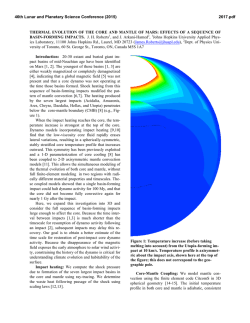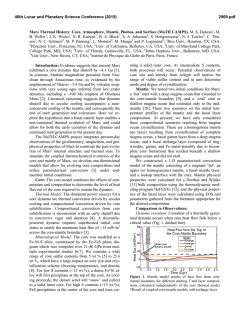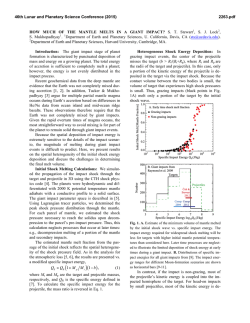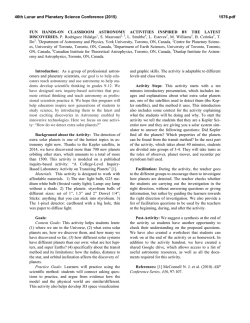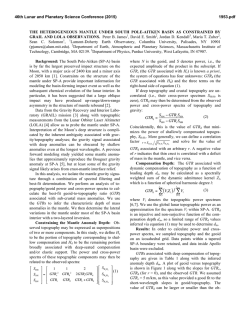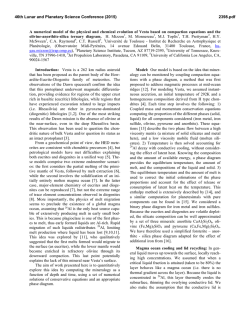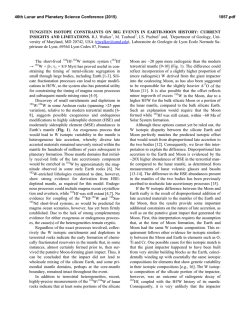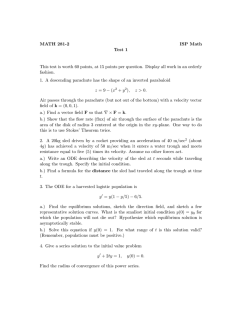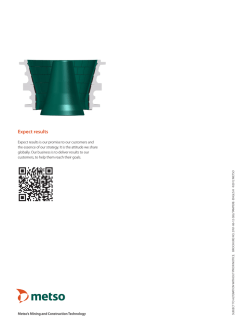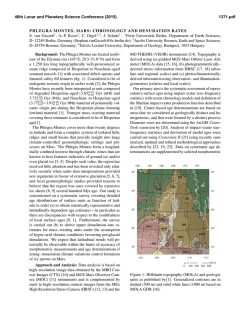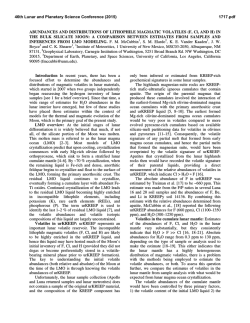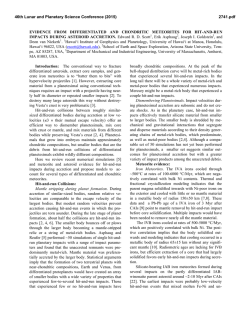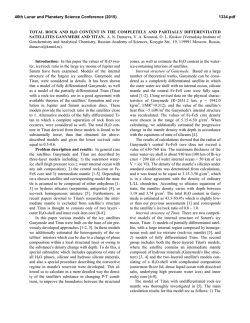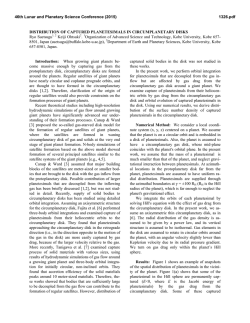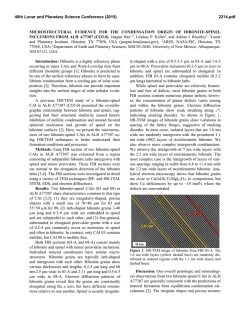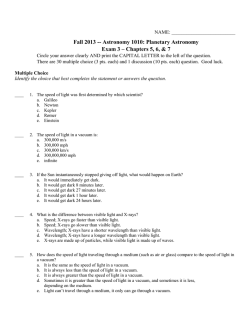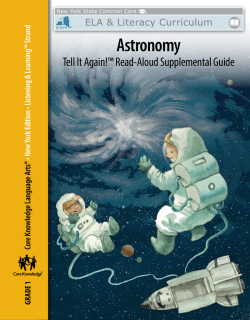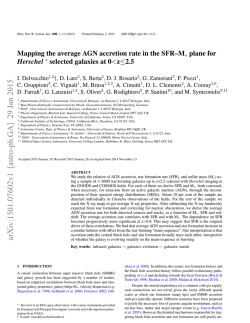
EFFECT OF FE REDOX STATE AND MG/SI RATIO ON EXOPLANET
46th Lunar and Planetary Science Conference (2015) 2908.pdf EFFECT OF FE REDOX STATE AND MG/SI RATIO ON EXOPLANET MASS-RADIUS RELATIONS. A. Lorenzo1, S.J. Desch1, S.-H. Shim1 and D. Nys1, 1School of Earth and Space Exploration, Arizona State University, Tempe AZ 85287 ([email protected]). Introduction: The number of transiting exoplanets whose masses and radii are accurately known is increasing each day [1,2]. This information can be used to probe the composition and interior structure of an exoplanet, provided models exist that relate the radius of a planet to its mass and composition, so-called “mass-radius relationships”. Several such models exist [3-7]. These models generally consider the rocky component to be perovskite, MgSiO3, which comprises the bulk of Earth’s mantle. The model of [3] considered a mantle composed of olivine, wadsleyite, ringwoodite (polymorphs of [Mg1-xFex]2SiO4), and perovskite and post-perovskite (polymorphs of [Mg1-xFex]SiO3), with x=0.1, similar to Earth. Many models also consider the effect of varying the core mass, essentially the bulk Fe/Si ratio. What these models do not explore is how variations in the planet’s bulk Mg/Si ratio affect the mass-radius relationship. And while [7] explored the effects of redox state and Fe on the mass-radius relationships, we take a second look at this variable using a different equation of state. To date most models generally consider a fixed Fe/Mg ratio in the mantle (x=0.1), and allow the mass of the core to vary. In practice, the bulk composition of the planet probably will approximate that of its host star, which can be measured. In that case, Fe/Si overall should be one parameter. What then determines the core size is the redox state of the planet, what fraction of the Fe is reduced (as core metal) as opposed to oxidized (in FeO in the mantle). To examine this effect (as distinct from core/mantle mass ratio per se), we fix the Fe/Si ratio and vary the percentage of Fe that is oxidized (XFeO). No models have considered variations in the Mg/Si ratio, even though observations of stars show this ratio varies significantly. The mean of this value is around Mg/Si=1.22 [9] or Mg/Si=1.32 [10], close to the solar value Mg/Si=1.05 [11], which itself differs from the value in Earth’s mantle, Mg/Si=1.26 [12]. But in individual stars the ratio can vary significantly, from Mg/Si < 1 to as high as Mg/Si > 2 [9, 13-14]. Many discrepancies exist between different datasets [15]. In their survey of planet-hosting stars, [13] found that 56% had Mg/Si < 1, and none with Mg/Si > 2, whereas [9] found that only 4% of such stars had Mg/Si < 1, but one had Mg/Si=1.75 and another (tau Ceti) had Mg/Si > 2. Within each survey, however, the spread in stellar compositions is considerable. On top of that, Mg/Si may be increased during planet formation; the value in Earth’s mantle is 20% higher than in the Sun. Perhaps this is attributable to events that vaporize the mantle, leading to preferential loss of more volatile Si compared to Mg. The detection of SiO vapor in the HD172555 system has been attributed to a mantlestripping impact and preferential loss of SiO [16]. In any event, it is worth considering the effects on planetary structure of a large range of Mg/Si values. For planets with Mg/Si > 2, such as those that might form in the tau Ceti system, the main difference from Earth is that the deep mantle should contain ferromagnesiowustite, [Mg1-xFex]O, in addition to the perovskite phases. For planets with Mg / Si < 1, the main difference from earth is that the deep mantle should contain high-pressure polymorphs of silica, in particular stishovite. Our goal is to understand how the introduction of these minerals changes the msas-radius relationships. Methods: We model the mass-radius relationships of exoplanets as follows. We assume they are composed purely of Fe, Mg, Si and O. A fraction XFeO (=13% for Earth) of the Fe is assumed to be oxidized as FeO and in the crust, a fraction (1- XFeO) remaining in the core as metallic Fe. All the Mg and Si reside in the mantle as MgO and SiO2. Together with the FeO, these form minerals in the FeO-MgO-SiO2 system. In this abstract we assume the only minerals are stishovite, perovskite, and magnesiowustite. The abundances of each mineral are determined by the molar fractions of Fe, Mg and Si. The partitioning of FeO between perovskite and magnesiowust, and the fractions x and y in the chemical formulas [Mg1-xFex]SiO3 and [Mg1-yFey]O, are found by imposing [(1-x)/x]pv / [(1-y)/y]mw = k = 0.45, where pv and mw are the mole fractions of perovskite and magnesiowustite [17]. Once the chemical abundances are determined, we find the equations of state for perovskite and magnesiowustite from [17], which include the dependences on x and y. For stishovite we use [18], and for the Fe core we assume epsilon Fe and the data of [19]. We use the isothermal bulk moduli fit to a third-order Birch-Murnaghan equation, then compute pressure P as a function of density ρ. We then perform a leastsquares fitting of this P(ρ) to the function ρ = ρ0 + c Pn [4], for both the core and mantle. From there we use standard techniques [20] to iteratively solve for the structure: we integrate the equation of hydrostative equilibrium dP/dr = - ρ(r) g(r) at fixed g(r) to find P(r), 46th Lunar and Planetary Science Conference (2015) use the equation of state to derive ρ(r), then update the volume and radii of each spherical zone in the planet. The result is the radius of the planet as a function of its mass (Mp) and composition (Fe/Si and Mg/Si ratios, as well as XFeO). Results: We first show the mass-radius relationships of exoplanets with Earth-like composition, but with variable XFeO between 1 and 99%. The range relevant to our solar system might be 0-20% [21]: for Mercury it is < 3% [22], Earth is 8% [23], Mars is 18% [24], and eucrites 18% [25]. This quantity is a function of the oxygen fugacity of the planet, which is sensitive to the composition. Figure 1 shows R(M) for a few different values of XFeO: 1%, 20%, 50%, and 99%. We find that over the range of values relevant to the Solar System, planet radius is very insensitive to FeO content of its mantle. Increasing FeO content of the mantle makes the planet denser, using the equation of state of [17]. For planets of 1 Earth masses, the XFeO=0.99 case has radius 0.8% smaller than that of the XFeO=0.01 case, increasing to 3.7% smaller for 5 Earth masses. This largely but not exactly confirms the findings of [7], who found that as XFeO ranged from 0 to 100%, the radius varied by at most 3% (at about 1 Earth mass), although the dependence on XFeO is in the opposite direction because of the different equation of state of [26] they used for [Mg,Fe]O, which becomes more compressible at higher XFeO. Figure 1: Planet radius versus mass for planets with fixed bulk Fe/Si ratio but various XFeO. We next show the mass-radius relations for planets with three different values of the Mg/Si ratio that span the range observed in stellar atmospheres: 0.9, 1.26 (Earth), and 2.1 (tau Ceti). We see relatively little sensitivity with respect to Mg/Si. Radius increases only slightly with increasing Mg/Si ratio. For planets up to 5 Earth masses, the most Mg-rich planets are < 2% larger in radius than the most Si-rich planets we consider. 2908.pdf Figure 2: Planet radius versus mass for planets with different bulk Mg/Si ratios. Conclusions: We find that across a wide variety of possible planetary compositions, including drastic changes in redox state (mantle FeO content) and Mg/Si ratio (leading to large mole fractions of stishovite or magnesiowustite instead of perovskite), the effect on the mass-radius relationships is small, only a few percent. Differences in density among exoplanets > 10% must be attributable to the presence of ice or atmospheres, but probably not rock mineralogy. Rock is rock. Acknowledgments: We gratefully acknowledge support from NASA Outer Planets Research, NASA Space Grant, and NASA’s Nexus for Exoplanet System Studies. References: [1] Marcy, G.W. et al. (2014) ApJS 210-279. [2] Weiss, L.M. and Marcy, G.W. (2014) ApJ 783, L6-12. [3] Valencia, D. et al. (2007) ApJ 665,1413-1420. [4] Seager, S. et al. (2007) ApJ 669, 1279-1297. [5] Swift, D.C. et al. (2012) ApJ 744, 5968. [6] Wagner, et al. (2012) A&A 541, A103-116. [7] Li, Z. and Sasselov, D. (2013) PASP 125, 227-239. [8] Yungshen Tian, B. and Stanley, S. (2014) ApJ 768, 156-164. [9] Pagano, M. (2014) Ph.D. Thesis, Arizona State Univ. [10] Bond, J.C. et al. (2010) ApJ 715, 1050-1070. [11] Lodders, K. (2003) ApJ 591, 12201247. [12] McDonough, W.F. and Sun, S.-s. (1995) Chemical Geology 120, 223-253. [13] Delgando Mena, E. et al. (2010) ApJ 725, 2349-2358. [14] Hinkel, N.R. et al. (2014) AJ 148, 54-86. [15] Young, P.A. et al. (2014) Astrobiology 14, 603-626. [16] Johnson, B.C. et al. (2012) ApJ 761, 45-55. [17] Jackson, I. (1998) Geophysical J. 134, 291-311. [18] Wang, F. et al. (2012) JGR 117, B06209. [19] Anderson, O.L. et al. (2001) GRL 28, 399-402. [20] Lorenzo, A. et al. (2014), LPS XLV, Abstract #1636. [21] Anderson, O.L. (1990) JGR 95, 21697-21707. [22] Izenberg, N.R. et al. (2014) Icarus 228, 364-374. [23] Jones, J.H. and Drake, M.J. (1986) Nature 322, 221-228. [24] Longhi, J. et al. (1992) in Mars (U. Arizona Press), pp. 184-208. [26] Stolper, E.M. (1977) GCA 41, 597-611. [26] Fei, Y. et al. (2007) GRL 34, L17307.
© Copyright 2025
